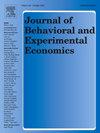Coordination in stag hunt games
IF 1.6
3区 经济学
Q2 ECONOMICS
Journal of Behavioral and Experimental Economics
Pub Date : 2024-09-14
DOI:10.1016/j.socec.2024.102290
引用次数: 0
Abstract
Stag hunt games display a tension between a payoff superior option (stag) and a less risky but payoff inferior alternative (hare). We explore that tension by proposing a selection criterion (which we denote as relative salience) where subjects choose to coordinate in one option by comparing the salience of stag’s main aspect (its payoff) to the salience of hare’s main aspect (its risk) by accounting for both payoff-relevant factors and unobservable individual-specific (idiosyncratic) preferences. Using data from 10 experiments, we find that this criterion is a significant determinant of individual choices in stag-hunt games, outperforming other selection methods.
雄鹿狩猎游戏中的协调
雄鹿狩猎游戏显示了一个报酬优越的选择(雄鹿)和一个风险较小但报酬较低的选择(野兔)之间的紧张关系。我们通过提出一种选择标准(我们将其称为相对显著性)来探讨这种紧张关系,在这种标准下,受试者通过比较雄鹿的主要方面(其报酬)和野兔的主要方面(其风险)的显著性,并考虑报酬相关因素和不可观测的个人特定(特异性)偏好,来选择在一个选项中进行协调。通过使用 10 个实验的数据,我们发现这一标准在雄鹿狩猎游戏中是个人选择的重要决定因素,优于其他选择方法。
本文章由计算机程序翻译,如有差异,请以英文原文为准。
求助全文
约1分钟内获得全文
求助全文
来源期刊
CiteScore
2.60
自引率
12.50%
发文量
113
审稿时长
83 days
期刊介绍:
The Journal of Behavioral and Experimental Economics (formerly the Journal of Socio-Economics) welcomes submissions that deal with various economic topics but also involve issues that are related to other social sciences, especially psychology, or use experimental methods of inquiry. Thus, contributions in behavioral economics, experimental economics, economic psychology, and judgment and decision making are especially welcome. The journal is open to different research methodologies, as long as they are relevant to the topic and employed rigorously. Possible methodologies include, for example, experiments, surveys, empirical work, theoretical models, meta-analyses, case studies, and simulation-based analyses. Literature reviews that integrate findings from many studies are also welcome, but they should synthesize the literature in a useful manner and provide substantial contribution beyond what the reader could get by simply reading the abstracts of the cited papers. In empirical work, it is important that the results are not only statistically significant but also economically significant. A high contribution-to-length ratio is expected from published articles and therefore papers should not be unnecessarily long, and short articles are welcome. Articles should be written in a manner that is intelligible to our generalist readership. Book reviews are generally solicited but occasionally unsolicited reviews will also be published. Contact the Book Review Editor for related inquiries.

 求助内容:
求助内容: 应助结果提醒方式:
应助结果提醒方式:


